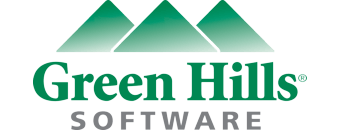Free Software Is Just Too Expensive
Development engineers and managers often get "free" compiler and debugger tools bundled with their RTOS, or directly from GNU, and are reluctant to spend an additional $6K or so for Green Hills tools. Looking at the total project picture, beyond just the incremental price of the tools, can shed new light on the cost-effectiveness of Green Hills tools.
"I looked at your tools, and I really like MULTI®, but I've already got free tools. I can't justify an additional $6K per seat."
Consider the following:
-
MULTI has many powerful features and productivity enhancements designed to save you development time and money.
-
What percentage productivity improvement will you achieve with MULTI? 30%? 20%? 15%? 10%? Let's see:
- MULTI will provide a MINIMUM of 5% additional productivity as follows:
- "At least once a month you must run into a memory overrun
error, array bounds error, memory leak, something freed twice,
an access through an invalid pointer, or an uninitialized variable
problem that takes at least a day to find and fix that could have
been avoided by MULTI's memory error checking." That's
5%.
- Each programmer spends at least one day a month trying to figure
out why their program is too slow. The MULTI profiler tells
you in seconds with no need to recompile. That's another 5%.
- At least once a month every programmer spends a day trying to
figure out why a piece of code changed or who changed it. The "Show
last Edit" command in MULTI's version control can show
you in seconds. That's another 5%.
- With the MULTI data explorer, you can traverse a linked
list or display a complex data structure on the screen in seconds
that could take 10 minutes in another debugger. This comes up several
times per day. Twenty-eight minutes a day is another 5%.
- With most RTOS debug solutions, having one window per task makes
multi-task interaction bugs incomprehensible; MULTI's window-per-task makes
finding these bugs easy. Integrated browsing allows you
to click on a function to see it, display call graphs and class
browsing all much more efficiently than using a text editor.
- True C++ debugging is critical; trying to decipher C++
data structures with a C debugger is incredibly time consuming.
- MULTI's completely integrated environment, including editor,
performance analysis, and debugger, are much more efficient because
they are designed together instead of thrown together.
- Now, in addition, how much support do you think you'll get from
the vendor of the "Free" tools? Not much. This affects productivity.
With MULTI, you get commercial level, professional support,
because we expect to provide it, and because we dedicate over 15%
of our engineering team to customer support. Full time. A programmer
foundering without support for one day a month costs him another
5%.
- All in all, MULTI is worth at least 5% in improved productivity.
- "At least once a month you must run into a memory overrun
error, array bounds error, memory leak, something freed twice,
an access through an invalid pointer, or an uninitialized variable
problem that takes at least a day to find and fix that could have
been avoided by MULTI's memory error checking." That's
5%.
- Small Relative Price. Programmers cost about $150,000 per
year. Other product development costs increase that cost. In 5 years,
you'll spend over $750,000 per developer. The cost difference between
MULTI and GNU is $6,000 per developer. MULTI's price is less than 1%
of your total cost for that programmer.

- Cost of Missing 5%. In five years, "Free Software" will
cost you 5% of $750,000 or $37,500 per seat. Clearly "Free Software"
costs much more than MULTI, seat for seat. Cost exceeds Tool Price.

- Value. You hired all these programmers that cost you $150,000
each. Presumably, you believe that they will produce something of greater
value, much more than the $150,000 they cost. The $37,500 derived above
was only the cost, not the value. The value would be
much greater, and would easily overcome the cost of the tools. So,
"Free Software" actually costs you much more than $37,500. Value
exceeds Cost.
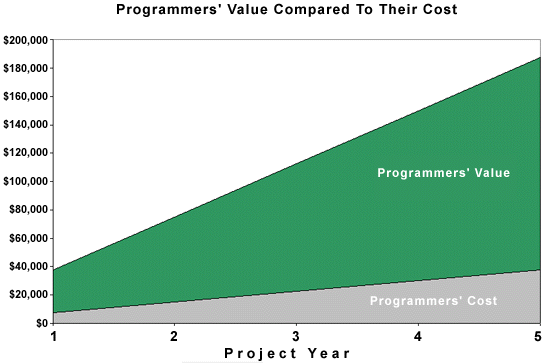
- Time to Market benefits derived from increased productivity
are staggering. Your time-to-market will be improved by using MULTI.
Every week you save in time to market translates into additional market
share, not just earlier market share. Combined with the fact that MULTI
costs only a couple of percent of your total programmer's cost to start
with, this improved time to market doesn't have to be very big to result
in elimination of the cost of MULTI. A 3 month earlier time to market
represents 3 months of sales at the maximum sales rate, not at the
initial rate. Free Software costs you these lost sales. Lost Sales
far exceeds Value.
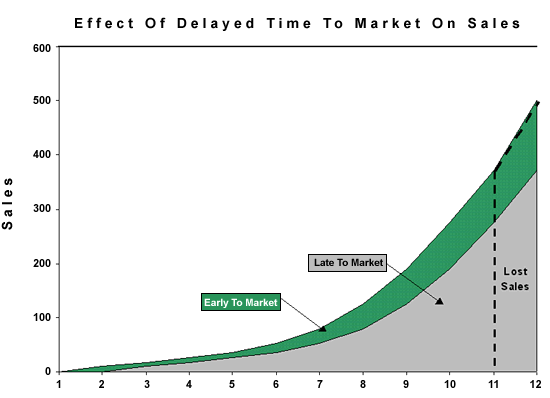
- Time To Market, in the presence of competition, is even more
critical. The first to market can expect to achieve a dominant position,
perhaps 50% - 70% market share. The followers might only get a 20%
share. The aggregate revenue and profits from the leadership position
are enormous. Reaching market before your competition is crucial in
a competitive environment. "Free Software" costs you this reduction
in market share. Time to Market far exceeds Lost Sales.
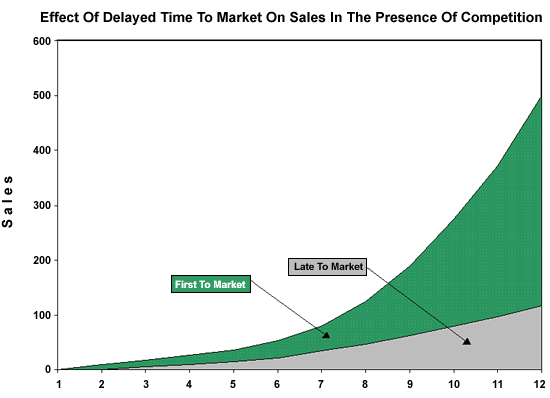
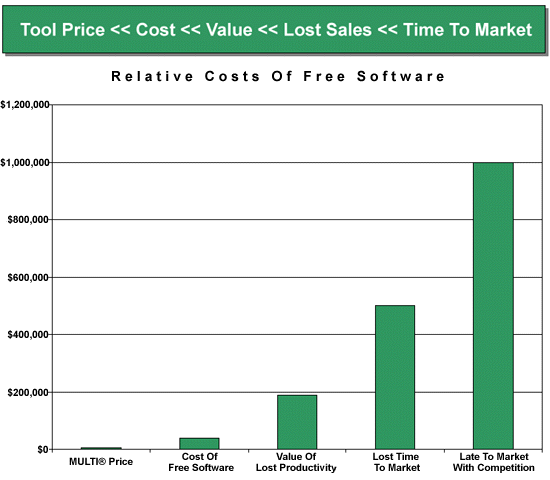
($6,000 is 2 weeks out of $150,000/year)
By recognizing that MULTI offers even just 5% added value:
- You should see that the product purchase cost difference is insignificant.
- The gain in productivity more than offsets the cost difference.
- The initial purchase cost difference should not be a factor in your decision! Productivity is so much more important. To believe otherwise is like saving $1,000 by putting low performance ("free") tires on a new $150,000 Ferrari. "Penny-wise and Pound-foolish."
- Compared to MULTI, "Free Software" is just too expensive.
